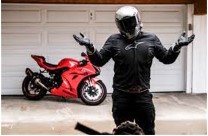Articles on Motorcycle Rider Education: Part VI – Learning Riding Skills
The process of learning riding skills consists of multiple skill sets that will create an end result of happiness and pleasure in most students. The concepts, generalizations, and skills gained include both mental (rational and cognitive) and motor (physical), which may enable a student to ride with safety in mind (get it?).
Physical Skills Involve More Than Muscle
There are some physical actions that happen regardless of thought because they are so engrained in our being. This statement isn’t wholly true as a thought process does happen, it has just become an autonomic function and resides at a different level of thought. A great example of this is breathing, as it happens without though – and yet with thought you can control its action. When considering learning a new physical action, there is a requirement for a student to think about the action in order to manage their motion or motor skill and then with steady and consistent proper practice, the skill may actually become more autonomic.
Desire to learn

Past experiences are a great repository for potential future learning. If a student can correlate past experiences, they may be quite surprised at how much quicker the new skills can be learned. This is considered a portion of the law of readiness and the RiderCoach can be an integral catalyst in this transaction. RiderCoaches MUST quickly gauge and query students about their experiences to be able to facilitate this type of learning, and with practice, it is not difficult to do.
A student’s need (desire) to learn can enhance learning, creating rapid progress and improving how a skill is retained. Conversely, if there is little desire or motivation to learn, little progress can be made. Improvement requires the willingness to recognize and make mistakes in the learning process and then make continued efforts to correct the mistakes. A person who lacks the desire to improve is not likely to make the effort of correction and will continue to practice errors. A skillful RiderCoach relates the lesson objectives to a student’s previous experiences and understood needs, building upon the student’s desire and enthusiasm.
Following Patterns
To best emphasize the methods for student learning, it is necessary to provide a clearly articulated step-by-step example for task performance. Having a model to follow, allows the student to have a mental picture of a task, in normal sequence, describing what it is, and how to do it. In rider education, the RiderCoach provides the correct demonstration while emphasizing the focused path of travel, appropriate techniques to the student. This is accomplished so that students can gain a clear impression of what will be expected of them.

Skill Performance
Learning the various skills required to operate a motorcycle requires practice. Beyond the basic operation of the motorcycle, where skill is attained, another benefit of practice during a course is that instructions and input from the RiderCoach are validated and become more meaningful. Long detailed explanations are confusing to a student and distracts from developing concrete understanding; however, once a skill is performed in practice, short specific comments can have incredible effect and become more useful after the objectives have been significantly accomplished.
Knowledge of Results
With simple skills, students can easily discover their own errors during the learning process. With more advanced skills and complex maneuvers, mistakes are not always apparent or a student may know that something is wrong but not know how to correct it. This is a prime function of the RiderCoach where helpful and sometimes critical information can be discussed and provide a student with knowledge of their current progress. In this vein, it is also important to receive information when they are accomplishing a task to standard so they may understand success! Informative feedback should be accomplished as soon after the performance as possible, this is important because students should not be allowed to practice making mistakes. It is more difficult to unlearn a mistake and then learn it correctly, than to learn it correctly in the first place. If necessary, one way to refocus students and make them aware of their progress in to repeat a demonstration, showing them the standard to which they are being compared.
Evaluation Not Critique
Initially, practice feedback is more valuable to the student than any grade could ever be. Early evaluation is conducted as friendly advice for “The Coach”. Feedback provides a check on the effectiveness of the RiderCoach and can be used to predict eventual student learning, proficiency, and will also allow a coach to locate special problematic areas. Observations are the basis for which evaluations are based and can identify the strengths and weaknesses of not only the student but also the coaching. A key aspect of feedback and evaluation is that it should not become and chastising critique, which would condemn the openness of the learning process. Feedback and evaluation should be based on the objectives and standards determined as necessary within the curriculum.
Application of Skill
The final and critical problem of Rider Education is the safe use of the motorcycle. This is determined by how a student can use what has been learned from the instruction received during the course. It is not uncommon to find that students who were dedicated to meeting objectives during the class have difficulty applying what they have learned on the street. To help with these issues, it becomes necessary to ensure that certain conditions are met during the course: (1) The student must show that the objectives have been met and that it has become easy for them to apply; and (2) the student must be able to recognize the types of situations where the skills are appropriate to use. The second condition relates to the transfer of learning and will be discussed in a later article
Until then, Ride and Coach Safe!
Originally Published February 19, 2017 on LinkedIn
© 2017, Donald L. Green, Rider Choices








